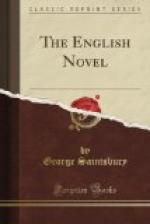As has been partly said, the means by which this effect is achieved, and also the means by which it is not, are almost equally remarkable. The Four Elements of the novel are sometimes, and not incorrectly, said to be Plot, Character, Description, and Dialogue—Style, which some would make a fifth, being rather a characteristic in another order of division. It is curious that Defoe is rebellious or evasive under any analysis of this kind. His plots are of the “strong” order—the events succeed each other and are fairly connected, but do not compose a history so much as a chronicle. In character, despite his intense verisimilitude, he is not very individual. Robinson himself, Moll, Jack, William the Quaker in Singleton, even Roxana the cold-blooded and covetous courtesan, cannot be said not to be real—they and almost every one of the minorities are an immense advance on the colourless and bloodless ticketed puppets of the Middle Fiction. But they still want something—the snap of the fingers of the artist. Moll is perhaps the most real of all of them and yet one has no flash-sights of her being—never sees her standing out against soft blue sky or thunder-cloud as one sees the great characters of fiction; never hears her steps winding and recognises her gesture as one does theirs.
So again his description is sufficient: and the enumerative particularity of it is even great part of the secret de Polichinelle to which we are coming. But it is far from elaborate in any other way and has hardly the least decoration or poetical quality. Well as we know Crusoe’s Island the actual scenery of it is not half so much impressed as that even, for instance, of Masterman Ready’s—it is either of the human figures—Crusoe’s own grotesque bedizenment, the savages, Friday, the Spaniards, Will Atkins—or of the works of man—the stockade, the boat, and the rest—that we think. A little play is made with Jack’s glass-house squalor and Roxana’s magnificence de mauvais lieu, but not much: the gold-dust and deserts of Singleton are a necessary part of the “business,” but nothing more. Moll Flanders—in some respects the greatest of all his books—has the bareness of an Elizabethan stage in scenery and properties—it is much if Greenfield spares us a table or a bed to furnish it.




